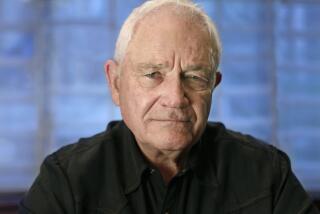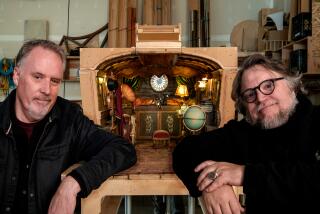Dino De Laurentiis, storied movie producer, dies at 91
Dino De Laurentiis, the flamboyant Italian movie producer who helped resurrect his nation’s film industry after World War II and for more than six decades produced films as diverse as the 1954 Federico Fellini classic “La Strada” and the 1976 remake of “King Kong,” has died. He was 91.
De Laurentiis, who moved to the United States in the 1970s and continued to produce films until 2007, died Wednesday night at his Beverly Hills home, his daughter Raffaella De Laurentiis, said in a statement Thursday. The cause was not given.
A consummate showman whose epic career belongs to a bygone era of Hollywood grandeur, De Laurentiis produced more than 160 films.
“I don’t think anyone will ever top Dino,” David Lynch, who directed “Blue Velvet” for De Laurentiis, said Thursday. “Ask anybody — he just never let up. He always had fun. He loved the cinema world. He was always thinking of the next thing.”
“The world lost a great entrepreneur, genius and salesman with the passing of Dino De Laurentiis,” California Gov. Arnold Schwarzenegger, who starred in the producer’s “Conan the Barbarian,” said in a statement. “Dino always treated me like a son and gave me my first big break in the movie business.”
De Laurentiis launched his long career as a producer in Italy in the 1940s and in the next decade produced two Oscar-winning best foreign films — Fellini’s “La Strada” (with then-partner Carlo Ponti) and Fellini’s “Nights of Cabiria” (1957).
During the De Laurentiis-Ponti partnership in the ‘50s, they launched into foreign film production in Italy, producing director Mario Camerini’s “Ulysses,” starring Kirk Douglas, Silvana Mangano and Anthony Quinn; and King Vidor’s “War and Peace,” starring Audrey Hepburn, Henry Fonda and Mel Ferrer.
As film producers in Italy after World War II, “De Laurentiis and Ponti in particular took the function of producer, which had never been highly regarded in European cinema before this, and raised it to a higher level,” said USC film professor Rick Jewell.
De Laurentiis, Jewell told The Times in 2007, “was involved with some very important films at that time. Those films didn’t just help resurrect the Italian film industry but brought attention to the Italian film industry that it had never done before.”
While mentioning De Laurentiis-produced films by Italian directors such as Fellini, Vittorio De Sica and Roberto Rossellini, Jewell said De Laurentiis also “got involved in foreign productions in Italy at a time when Hollywood in particular was looking to make films overseas for various reasons, and he jumped on that with films like ‘War and Peace’ and ‘Ulysses.’ ”
In 1962, the prolific producer began building a sprawling studio complex on the outskirts of Rome that he called Dinocitta — Dino City.
During the 1960s — he is credited with pioneering the now-common practice of financing films by pre-selling the distribution rights in foreign countries — De Laurentiis produced films such as director Richard Fleischer’s “Barabbas,” starring Anthony Quinn; John Huston’s star-studded “The Bible”; and Roger Vadim’s “Barbarella,” starring Jane Fonda.
His company also produced Franco Zeffirelli’s adaptation of “Romeo and Juliet.”
After selling his studio and moving to the United States in the 1970s, De Laurentiis produced films such as “Serpico,” “Death Wish,” “Three Days of the Condor,” “The Serpent’s Egg,” “Ragtime” and “Conan the Barbarian.”
But his name also became synonymous with expensive box-office failures such as “Dune,” “Tai-Pan” and “King Kong Lives.”
Veteran Associated Press Hollywood reporter Bob Thomas once summed up De Laurentiis’ varied output as “high-brow and low-brow, huge moneymakers and expensive flops.”
Hit or miss, in an industry in which directors are deified, De Laurentiis had no doubt as to where he stood in the cinematic scheme of things.
“If no producer, no movie,” he growled in a 2002 interview with Canada’s the Globe and Mail.
By 1985, De Laurentiis was running a 32-acre movie studio in Wilmington, N.C. The same year, he acquired Embassy Pictures and formed the De Laurentiis Entertainment Group, a distribution and production company.
Among the films produced under the DEG banner was Lynch’s “Blue Velvet,” which was a critical hit but a disappointment at the box office.
After producing what one analyst called “too many high-priced films, which had minimal commercial value,” De Laurentiis stepped down as chairman in February 1988, and six months later his company was forced to file for bankruptcy.
But in 1990, the producer obtained backing from an Italian friend and formed another company, Dino De Laurentiis Communications.
“De Laurentiis has that quality that all great producers have, which is — I suppose momentum is the best word I can think of,” Jewell said. “This is a guy that always had that forward momentum. It was basically self-generated, but you have to have it” as a successful producer.
In 2001, De Laurentiis received the prestigious Irving G. Thalberg Memorial Award, which is given by the Academy of Motion Picture Arts and Sciences Board of Governors in recognition of “creative producers whose bodies of work reflect a consistent high quality of motion picture production.”
De Laurentiis, who became a U.S. citizen in the mid-1980s, also received the Producers Guild of America’s 2004 David O. Selznick Award for his “historic contributions to motion pictures as the champion of many of our industry’s greatest talents and as a true visionary of international cinema.”
One Italian observer of the movie scene told The Times’ Rome bureau chief in 1976: “Dino has made virtues out of his faults. He is crude, rude and capricious. He treats people as buttons to be pushed. I’m not even sure he cares that much about movies. It is the deals that he loves, the wheeling and dealing. And he’s a genius for publicity. He has a childlike quality, and most people can’t help being charmed by him — even if they live to regret it.”
As a producer, De Laurentiis was known as a man who never took no for an answer.
When Kurt Russell initially turned down the starring role in the 1997 action-thriller “Breakdown” — it was to be shot in the Utah and Arizona desert, and Russell had just made two films on location and wanted to stay home in Pacific Palisades with his family — De Laurentiis came up with a way for the actor to sleep at home each night.
He instructed director Jonathan Mostow to find desert locations near airfields that could accommodate small jets: Russell was picked up at home each morning, driven to Van Nuys Airport and flown to the desert airstrips in a Lear jet. He was then helicoptered next to his trailer at the location.
“I’d get Kurt for one shot before lunch, then we’d shoot till 5 p.m., when we’d hear the helicopter coming in, like ‘MASH,’ signaling that it was time for him to go,” Mostow told The Times in 2001. “It was crazy, but like a lot of Dino’s ideas, it worked.”
Of course, De Laurentiis didn’t always get what he wanted.
When Jodie Foster, director Jonathan Demme and screenwriter Ted Talley all turned down making “Hannibal,” the 2001 sequel to the hit crime thriller “The Silence of the Lambs” (which De Laurentiis had not produced), he simply forged ahead with another female star, director and screenwriter.
As he put it: “The pope dies, you get another pope.”
The son of a pasta manufacturer, he was born Agostino De Laurentiis on Aug. 8, 1919, in Torre Annunziata, near Naples.
One of seven children, he dropped out of school at 15 and traveled as a salesman for his father’s pasta factory. But he wasn’t enamored of the family business.
In 1937, the movie-struck teenager was accepted to the first-year acting course at a new film school in Rome, Centro Sperimentale di Cinematografia.
At the end of the year, De Laurentiis realized he didn’t have the makings of a successful actor and realized he’d rather be behind the camera — as a producer.
He worked for a time as an extra, stagehand, electrician and director’s assistant before changing his first name from Agostino to Dino and launching a production company.
After producing two short films, he bought the remake rights to a Swedish film and produced his first feature movie, “L’amore Canta” (“Love Sings”), which was released in September 1941 when he was 22.
A remake of a German film followed, and that led to his receiving a one-year contract as a producer at the Lux studios in Rome.
His budding producing career was finally interrupted by World War II while he served for a time in the Italian army organizing shows to entertain troops.
After the war, he returned to producing at Lux studios and scored his first international success with Giuseppe De Santis’ “Bitter Rice,” a 1949 drama set among women working in the rice fields of the Po Valley in northern Italy.
The film’s cast included Silvana Mangano, whom De Laurentiis married in 1949 and with whom he had four children: Veronica, Raffaella, Federico and Francesca. The couple divorced in 1989. Federico, 26, died in an airplane crash while making a documentary in Alaska in 1981.
In 1990, De Laurentiis married producer-colleague Martha Schumacher, with whom he had two daughters, Carolyna and Dina.
Besides his wife and five daughters, De Laurentiis also leaves five grandchildren, including Food Network host Giada De Laurentiis; three sisters; and two great-grandchildren.
Funeral arrangements are pending.
Times staff writer Elaine Woo contributed to this report.
More to Read
Start your day right
Sign up for Essential California for the L.A. Times biggest news, features and recommendations in your inbox six days a week.
You may occasionally receive promotional content from the Los Angeles Times.






